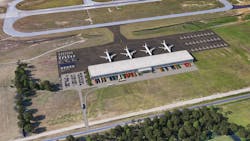Airport-First Mentality Puts Aviation Projects in New Light

When film producers for the Korean War epic, “Devotion,” approached the Statesboro-Bulloch County Airport about transforming part of its airfield into a theater of military operations with a replica mid-20th century aircraft carrier, the logistics went far beyond building a set on site.
Utilizing 100 acres of the airfield including a crosswind runway required coordination with the Georgia Department of Transportation, the Federal Aviation Administration, and well as local government authorities. It included a construction safety and phasing plan along with developing an airport safety special event plan.
While not a typical project for a general aviation airport, it was emblematic of the scope an airport project can encompass. When general aviation airports undergo improvements or expansions, they are more than a transportation project; they are major infrastructure projects, with a direct impact on economic development and community vitality.
As communities across the Sun Belt and Mid-South experience transformational growth, airport projects are becoming a vital component enabling these communities to compete for investment and business, in addition to serving residents. Across the United States, the FAA estimates airport development to reach more than $62 billion from 2023 to 2027, with small and medium hubs representing the fastest part of those infrastructure needs.
As a vital component to economic development, what seems contained within the airport expands beyond its properties with impacts that affect both residents and land development. For any airport improvement or expansion project to be successful in today’s climate, it requires an approach that is both long-term and mindful of those impacts.
Today’s projects require a holistic approach, moving beyond engineering and security mandates to also incorporate land-use planning and financing. Through this holistic lens, airport initiatives can elevate beyond the technical improvements to position these facilities and airfields as engines of growth and vitality.
An Airport-First Approach
Airports are more than what meets the eye. While passengers can see them through the lens of a user-centric complex, they are employment centers, business attractions, national strategic assets, and tax generators.
That makes any airport improvement or expansion project a vital initiative. Despite the FAA’s projections for airport development spending, the infrastructure needs for airports across the nation are more than double that cost, rising to $151 billion, according to the Airports Council International-North America. These needs come at the same time when constructions costs have risen astronomically, more than 40% overall since 2012 and anywhere from 28-35% in the past couple of years due to inflation and supply-chain costs.
To say such cost inflation has forced some airport authorities to rethink development projects would be an understatement.
Yet, postponement is not an option for some of those management authorities. In the Huntsville, Ala., metropolitan region, the population grew 16 percent from 2010 to 2020, with Huntsville itself growing more than 22%. Now Alabama’s largest city, it benefits from a strong aerospace industry as well as manufacturing and the military.
Such growth not only puts pressure on large international airports such as Huntsville International, but it forces nearby general aviation airports like Decatur’s Pryor Field to also respond to the growth.
The challenge for these smaller airports is as much a financial one as an engineering and zoning one. When dealing with 35% increases in construction costs, the market is highly competitive to secure revenue where they can. Funding from the Bipartisan Infrastructure Law aside, grants through traditional funding streams like the Airport Improvement Program have not kept pace with the growing infrastructure needs, and user fees collected through passenger facility charges can be restricted in their uses as well as restricted to commercial services airports.
Working with industrial development authorities becomes key to advancing airport projects. Partnering with such authorities, the design and engineering team is able to identify and obtain on the federal and state level the incentive packages for tax breaks as well as grants to advance projects even in the turbulent economic environment.
Because all airport improvement work goes through an FAA review, often times engineers and architects see where the funding drives a project rather than need. Knowing what to look for and where to access the funding, the project team, if positioned correctly, can do more to represent the interests of the owner and help them navigate the funding processes to secure the product they actually need.
Business Development vs. Project Management
On-time and on-budget is often the hallmark of a well-managed project. For the owner to really see the desired returns on the investment, the project also needs to be on-point.
The trickle-down effects of any airport project means that the projects are as much a community development initiative as they are an airport initiative. The fact is that commerce follows transportation, and the more modern and well-positioned an airport is to serve its users, the more the community is positioned to serve its local industry and residents.
In Bessemer, Ala., the municipal airport, EKY (using the airport’s IATA code) is working to develop a concept, known as The Aeroplex , which would weave together the traditional models of the airport as a public utility and economic development asset with a vision of the complex as a technology recruitment tool as well as an education center. It’s a comprehensive vision of the Aeroplex as a leading executive airport with community assets for technology incubation, immersive aerospace education, and even a 20-acre community park that would help raise the visibility of the airport’s contributions to the region.
For the project team, this means the initiative goes beyond geotechnical assistance, architectural design, environmental assessment, and sewers and wastewater treatment.
With airport boards usually populated with members invested in the community, getting insights into the community is vital to stewarding projects towards goals that have benefits beyond the airport. Developing a trusting relationship with airport managers, the project team can work in the trenches to identify opportunities and issues that impact project goals.
This approach to move project management into a business development realm puts the focus of the project on its future potential, not just its logistical present. It puts the airport board and manager in a position to communicate to investors a clear picture of what their investments could look like on the airfield and how that facilitates business in the community.
Growth and Diversification
Once playing the role of military training for pilots and crews in the Korean and Vietnam wars, general aviation airports now cater to and are the preferred option for companies who seek affordable, long-term leases and easy access for their needs.
At Pryor Field, the waitlist for hangar options currently is more than 100, making its 100-acre development plan vital to the region’s sustainability and growth.
The challenge for many general aviation centers, growth is not unbridled. It must be controlled, like zoning. In the same manner that zoning mitigates a liquor store from locating next to an elementary or secondary school, navigating the issues that could adversely impact airport operations takes both a working knowledge of those mandates and guidelines as well as a vision of where the community is going and how the airport can serve that vision.
This puts the architectural and engineering team in as much an advisory role as a service role. Airport leaders need to communicate both how their projects will come to completion as well as help their community. The knowledge the project team brings provides these leaders with the appropriate outlines and explanations to present the business plan for the airport complex.
This experience can also help owners identify and plan for revenue sources that can sustainably carry the operations through its 5-, 10-, or 20-year plan. Fuel flow, landing, and parking fees all promote growth and preserve revenue streams. A proper portfolio of documents outlining standards for potential revenue sources can also help airport leaders position their operations in a manner that maximizes the investment in the infrastructure project.
By providing timely and accurate information, project teams enable airport owners and managers to be more confident in their projects and their abilities to meet the vision for community development, whether that includes corporate, cargo, or general aviation operations. It also allows them to manage their costs in a climate where margins are tight.
Even for airport managers who work both day-in and day-out on their complex’s operations, knowing the ins and outs of all the regulations that must be followed in addition to seeking appropriate funding sources and developing business plans can be daunting. While a new taxiway is an engineering and design project, it is more than that and requires expertise by a project team who can counsel managers on those nuances.
The nation’s airports face some of the most challenging markets today yet also have the most exciting opportunities. From community growth and business expansion to innovations such as Amazon drone delivery, airports are uniquely positioned as part of America’s infrastructure to support a dynamic future of logistic and transportation operations.
The glorious successes of mid-century flight and military operations such as those in the Korean War brings a sense of pride to the role aviation plays in our economy. While the future looks different, it’s a look that, approached competently, can fit general aviation complexes for years and bring a new sense of pride to the communities they serve.
Ryan Pearce, PE, is Vice President, Aviation, with Goodwyn Mills Cawood.
About the Author

Ryan Pearce
Vice President, Aviation
Ryan Pearce, PE, is Vice President, Aviation, with Goodwyn Mills Cawood. He can be reached at [email protected].